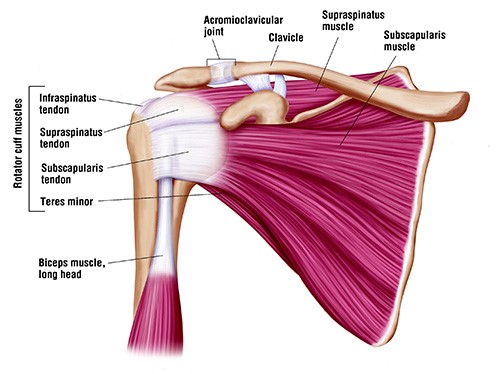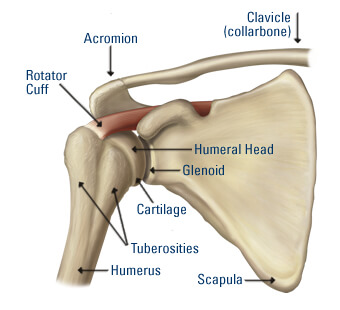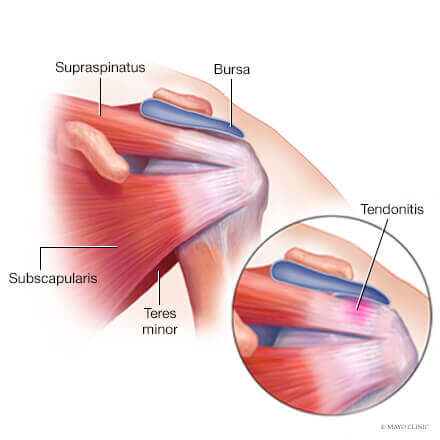What are the most common, how do they happen and what can be done?
Shoulder pain is stated to be the third most common reported musculoskeletal condition in adults in the UK. Around 70% of people will experience at least one episode of shoulder pain in their lifetime and it is estimated that 3% of the population visit a primary healthcare provider like Care For Health each year.

The anatomy of the shoulder is a complex consisting of four major joints. The two that are most commonly linked with pain are the glenohumeral joint (ball and socket) and the acromioclavicular joint (link between collar bone and bony part of shoulder). The glenohumeral joint has a shallow socket lined with cartilage which allows the shoulder to move smoothly in multiple directions. This is important for daily tasks such ironing and reaching behind in the car putting your seatbelt on. However it is also vital in more extreme movements in sport such as a fast bowl in cricket or using the rings in gymnastics.

There are also a number of soft tissues which need to work in synchrony to stabilise the joint and also move the shoulder during its wide range of movement. These include the ligaments, tendons, deep rotator cuff muscles and the primary movers of the shoulder which sit more superficial. These primary movers include the deltoids, biceps, triceps, trapezius and pectoral muscles.
Three Most Common Types of Shoulder Injuries we see in the clinic
Shoulder impingement
During the complex movement of the shoulder, the muscles and tendons are designed to move freely without restriction in a space between the acromion (bony part on top of the shoulder) and the humerus (top of the arm). Impingent occurs when these soft tissues become “pinched” and overtime leads to irritation. There are a number of different factors that can lead to impingement. Firstly, postural changes which seem to be increasing prevalent in today’s age as a result of increased office desk use and looking down at our mobile phones. Classic postural changes include rounding of the shoulders and a forward head carriage. This in turn leads to a narrowing of the joint space compressing on the soft tissues which pass through it. Muscular imbalances and overuse of the shoulder during certain movements can also lead to an increased friction on the soft tissues in the space. All of these factors will lead to irritation resulting in inflammation and pain with movement. The classic primary symptom being when the arm is lifted up to the side as this is where the joint is at its most compressed.
Another factor leading to shoulder impingement can be structural changes in the shoulder joint. Commonly a downward sloping collar bone can develop overtime which again will narrow the space for the soft tissues to pass through resulting in inflammation and pain during movement.
With this in mind it is important to receive regular adjustments from your chiropractor to ensure that you have any interference removed between joints which in turn will promote a healthy posture.

Rotator Cuff Tendinopathy
This is one of the most common shoulder injuries with at least 30% of the general population experiencing symptoms of rotator cuff tendinopathy in their lifetime. For most people the area of pain can be difficult to pin point as the rotator cuff muscles lay deep in the shoulder joint. The primary role of a tendon is to attach the muscle to its attachment site at the bone pulling the bone to produce movement. Tendons are designed in way which enables them to deal with high levels of force during daily activities such as carrying heavy shopping bags to gripping overhead on a climbing wall. Even sleeping on the affected shoulder can eventually become uncomfortable if left untreated. Tendons can only sustain so much force and with gradual overload this will lead to micro tears in the tissue resulting in swelling, inflammation and eventually pain. Failing to seek attention from a musculoskeletal specialist early on will result in the tears becoming chronic thus leading to significant weakness of the shoulder in certain positions making it difficult to carry out even the most simple of daily tasks.
This type of injury can also arise with degeneration of the tendon. This is a process that naturally occurs with age and is similar with other parts of the body i.e. joints of the spine if you don’t look after them. Without having the appropriate strength in tendons whilst carrying out lifting or pulling tasks i.e. sweeping up leaves in the garden, you are more susceptible to sustain a buildup of micro tears in the tendon resulting in pain and disability of the shoulder. So ensure to speak to your sports therapist for simple and effective strengthening exercises to maintain strength and mobility to help bullet proof your shoulders.

Frozen Shoulder (adhesive capsulitis)
This is a very common injury we see in clinical practice however the research is still unclear exactly what causes it. The shoulder capsule is a fibrous tissue which surrounds the shoulder and helps keep the glenohumeral joint in place. During a frozen shoulder the capsule thickens, scars and shrinks around the joint primarily leading to stiffness with a limited range of motion. A common sign with this injury is stiffness and pain whilst reaching your hand behind your back, i.e. doing up your bra. Another sign which aids with the diagnosis of a frozen shoulder is its prevalence with certain groups. Ladies, between age of 45-60 and diabetics are all shown to be at a greater risk of developing the condition. Here are the three typical stages of a frozen shoulder;

Acute/Freezing phase (3-9 months) – gradual onset of pain, significantly at end of range movements. Sleeping on the affected shoulder can also be uncomfortable in this stage
Adhesive/Frozen phase (4-12 months) – initial sharp pain starts to subside however this is where the stiffness during specific movements is most severe and restricted
Resolution/Thawing phase (1- 3 years) – You will start to notice a spontaneous improvement in range of motion gradually realising that the tasks you found difficult initially are becoming easier!
These different phases will vary in duration and can significantly overlap so that’s why it is important to know from your sports therapist what type of exercises you should be doing at each different phase to speed up recovery.
What can you do about these injures?
Although these are three different conditions of the shoulder, the rehabilitation principles are very similar. The initial stage aims to reduce pain whilst regaining the range of motion. This leads on to strengthening the supporting muscles of the shoulder whilst ensuring that you are now able to carry out the movements that initially hurt now without pain. Even though these principles are similar, it is still extremely important that you see someone who can help diagnose your shoulder injury and will provide you with the most appropriate treatment alongside the most up to date rehabilitation program. If you just leave these shoulder injures they won’t settle down on their own and can become chronic and extremely debilitating affecting both daily life activities and sport and exercise.
If you or someone you know is suffering with shoulder pain try not to delay doing something about it. You (or they) can speak to one of the sports therapists at Care for Health who can diagnose and put you back on the right path to wellness.


